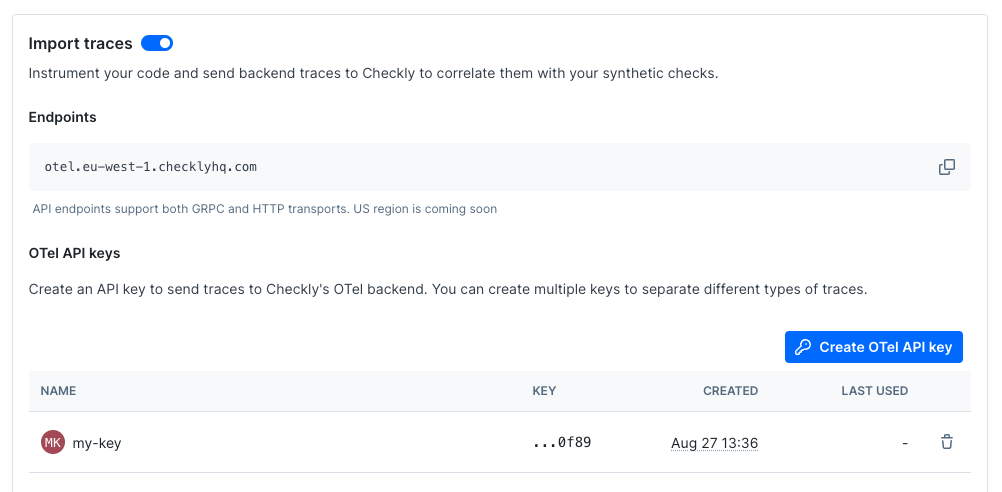Flask
This guide will help you instrument your Flask application(s) with OpenTelemetry and send traces to Checkly.
Step 1: Install the OpenTelemetry SDK
Install the relevant OpenTelemetry packages:
pip install opentelemetry-distro \
opentelemetry-exporter-otlp
Use the opentelemetry-bootstrap command to automatically install any OTel libraries based on your current Python app.
opentelemetry-bootstrap --action=install
Step 2: Initialize the instrumentation
Notice the HttpHeaderSampler class. This is a custom, head-based sampler that will only sample spans that are generated
by Checkly by inspecting the trace state. This way you only pay for the egress traffic generated by Checkly and not for
any other traffic.
from opentelemetry import trace
from opentelemetry.sdk.trace import TracerProvider
from opentelemetry.exporter.otlp.proto.http.trace_exporter import OTLPSpanExporter
from opentelemetry.sdk.trace.sampling import Sampler, SamplingResult, Decision
from opentelemetry.sdk.trace.export import BatchSpanProcessor
from opentelemetry.instrumentation.flask import FlaskInstrumentor
from opentelemetry.instrumentation.requests import RequestsInstrumentor
from flask import Flask, request
class HttpHeaderSampler(Sampler):
def get_description(self) -> str:
return "HttpHeaderSampler"
def should_sample(
parent_context, trace_id, name, kind=None, attributes=None, links=None, trace_state=None
) -> SamplingResult:
if request.headers.get('tracestate') == 'checkly=true':
return SamplingResult(Decision.RECORD_AND_SAMPLE)
else:
return SamplingResult(Decision.DROP )
trace.set_tracer_provider(TracerProvider(sampler=HttpHeaderSampler()))
trace.get_tracer_provider().add_span_processor(BatchSpanProcessor(OTLPSpanExporter()))
app = Flask(__name__)
FlaskInstrumentor().instrument_app(app, tracer_provider=trace.get_tracer_provider())
RequestsInstrumentor().instrument()
# define routes etc.
Step 3: Start your app with the instrumentation
Toggle on Import Traces and grab your OTel API key in the OTel API keys section of the Traces page in the Checkly app and take a note of the endpoint for the region you want to use.

Now, export your API key in your shell by setting the OTEL_EXPORTER_OTLP_HEADERS environment variable.
export OTEL_EXPORTER_OTLP_HEADERS="authorization=<your-api-key>"
Next, export the endpoint for the region you want to use and give your service a name.
export OTEL_EXPORTER_OTLP_ENDPOINT="https://otel.eu-west-1.checklyhq.com"
export OTEL_SERVICE_NAME="your-service-name"
Then, explicitly set the protocol to use for the OTLP exporter.
export OTEL_EXPORTER_OTLP_PROTOCOL="http/protobuf"
We are using the standard OpenTelemetry environment variables here to configure the OTLP exporter.
| Variable | Description |
|---|---|
OTEL_EXPORTER_OTLP_HEADERS |
The Authorization HTTP header containing your Checkly OTel API key. |
OTEL_EXPORTER_OTLP_ENDPOINT |
The Checkly OTel API endpoint for the region you want to use. |
OTEL_EXPORTER_OTLP_PROTOCOL |
The protocol to use for the OTLP exporter. |
OTEL_SERVICE_NAME |
The name of your service to identify it among the spans in the web UI. |
Finally, start your app with the Flask CLI:
flask run
🎉 You are done. Any interactions with your app that are triggered by a Checkly synthetic monitoring check will now generate traces, which are sent back to Checkly and displayed in the Checkly UI.
Last updated on June 18, 2025. You can contribute to this documentation by editing this page on Github